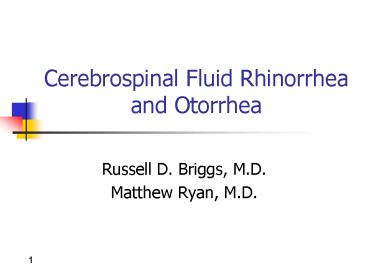Cerebrospinal Fluid Rhinorrhea and Otorrhea - PowerPoint PPT Presentation
1 / 39
Title:
Cerebrospinal Fluid Rhinorrhea and Otorrhea
Description:
Cerebrospinal Fluid Rhinorrhea and Otorrhea Russell D. Briggs, M.D. Matthew Ryan, M.D. Introduction Cerebrospinal fluid rhinorrhea/otorrhea Abnormal communication ... – PowerPoint PPT presentation
Number of Views:321
Avg rating:3.0/5.0
Title: Cerebrospinal Fluid Rhinorrhea and Otorrhea
1
Cerebrospinal Fluid Rhinorrhea and Otorrhea
- Russell D. Briggs, M.D.
- Matthew Ryan, M.D.
2
Introduction
- Cerebrospinal fluid rhinorrhea/otorrhea
- Abnormal communication between the subarachnoid
space and nose/temporal bone - Complications high
- Meningitis/brain abscess
- Challenge for diagnosis and treatment
- Important for otolaryngologists
3
CSF Rhinorrhea
- Connection of SA space to nose/sinuses
- Diverse etiologies
- Iatrogenic ESS
- Blunt trauma CHI or skull fractures
- Increased intraventricular pressure
- Tumors, post infectious/traumatic hydrocephalus
- Arachnoid granulations
4
CSF Rhinorrhea
- History and PE
- Unilateral watery rhinorrhea
- Increases with valsalva and posture
- May see leak/encephalocele with endoscope
- Collect fluid
5
CSF Rhinorrhea
- Ensure it a CSF leak
- Testing of secretions
- Beta-2-transferrin highly specific
- Glucose/protein determination
- Electronic nose
6
CSF Rhinorrhea
- Most important step identify the site
- High resolution CT of sinuses (1mm)
- Coronal good for anterior skull base
- Axial good for posterior wall frontal sinus
- Problem is volume averaging
- Look in cribiform niche and lateral wall of
sphenoid sinus
7
High resolution CT
8
High Resolution CT
9
CT Cisternogram
- Optimal imaging technique
- False negative if no active leak
- Obtain if HRCT fails to show the defect
10
Magnetic Resonance Imaging
- MR cisternographymisnomer as no intrathecal
contrast - Poor bony detail
- Uses highly T2 weighted images
- New method with intrathecal gad
- Encephaloceles
11
Radioisotope cisternography
- Many false positives and negatives
- Fallen out of favor
- No anatomic detail
- For selected cases when leak not identified
- Cottonoids in MM, SE recess
- Removed in 24 hours and tested
- If positive intrathecal florescein
12
Intrathecal Florescein
- IF leak not identified and strong suspicion
- Combined with endoscopic surgical approach
- Complications
- Topical use
13
Treatment of CSF Rhinorrhea
- Most resolve (after trauma/surgery)
- Bed rest, head elevation, stool softeners
- Possible lumbar drain/spinal taps
- Prophylactic antibiotics
- Surgical repair
- Extensive intracranial injury
- Intraoperative identification
- Do not respond to conservative measures
14
Surgical Treatment
- Intracranial
- Time tested
- Allows direct visualization
- Well vascularized flaps
- Success about 75
- High morbidity (anosmia, edema, hemorrhage,
incision, hospital stay)
15
Surgical Treatment
- Extracranial
- Uses facial incisions for direct visualization
- Success about 80
- Morbidity facial scarring
16
Surgical Treatment
- Endoscopic intranasal
- Preferred method of repair
- Successful 83-94 (average 90)
- Different techniques used
- Overlay vs. Underlay techniques
- Composite grafts
- Dependent on size and location of defect
- Sphenoid sinus
17
Surgical Techniques
18
Surgical Techniques
19
Surgical Techniques
- Use gelfoam and gelfilm (gt90)
- Use nasal packing (100)
- Consider fibrin glue (gt50)
- Consider lumbar drain
- 3-5 days
- Not required
- BR, stool softeners, antibiotics
20
CSF Otorrhea
- Connection of SA space and TB
- Acquired etiology is most common
- Trauma (temporal bone fracture), post-operative,
infections, neoplasms - Congenital etiologies
- Mondini deformities, wide CA, patent Hyrtels
fissure, wide fallopian canal - Arachnoid granulations (Spontaneous)
21
Temporal Bone Fractures
- Most common cause of CSF otorrhea
- Longitudinal vs. Transverse
- CSF from ear or nasopharynx
- HRCT
- Send fluid for beta-2-transferrin
- Bed rest, head elevation, stool softeners, occ
lumbar drain, sterile cotton, antibiotics (no
drops)
22
Temporal bone fractures
- Brodie and Thompson (1997)
- Review of 820 TB fractures
- 122 with CSF leak
- 95 closed in first week, 21 in second week, only
5 drained over two weeks - Seven patients had surgery
- Check scan and audiogram
- 9 developed meningitis
- ?Abx
23
Spontaneous CSF Otorrhea
- May be subtle
- Two types
- Preformed bony pathway present early
- Meningitis after AOM
- Resistant MEE recognized after MT
- Congenital defect (arachnoid granulations)
- Villi enlarge, weight of temporal lobe
- Bone erosion present over age 50
- MEE
24
Spontaneous CSF Otorrhea
25
Spontaneous CSF Otorrhea
26
Spontaneous CSF Otorrhea
27
Spontaneous CSF Otorrhea
- Beta-2-transferrin
- HRCT
- CT cisternogram
- MR cisternogram
- Surgical repair
28
Surgical Techniques
- Middle fossa defects
- Middle fossa craniotomy with extradural
elevation avoids ossicular problems - Transmastoid
- Posterior fossa defects
- Transmastoid/fat obliteration of mastoid
- Others
29
Conclusions
- Get a good history and PE
- Test the fluid (if possible)
- Find the site of the the leak
- Radiographically
- Treat it surgically if necessary
30
Case Report
- 45 yobf presents with headache and my neck hurts
31
Case Report
- 45 yobf presents with headache and my neck
hurts - Worsening for 2 weeks
- Photophobia, N/V
32
Case Report
- 45 yobf presents with headache and my neck
hurts - Worsening for 2 weeks
- Photophobia, N/V
- PMH meningitis 6 months prior, AR
- PSH hysterectomy
- Meds Flonase not helping constant drainage
- SH/FH/ROS NC
33
Case Report
- Physical Exam
- Positive Kernigs and Brudinskis
- Some clear rhinorrhea and hypertrophied turbs
bilaterally - Sits forward and clear fluid from right nare
- Otherwise normal H/N exam
34
Case Report
- Labs WBC 20.2 with left shift, remainder
essentially OK
35
Case Report
- Consult to neurology made
- LP cloudy fluid,many PMNs
- Streptococcus pneumoniae
- Placed on appropriate abx
- Improving
36
Case Report
37
Case Report
38
Case Report
39
Case Report
- Did not respond to conservative measures
- Taken to surgery
- Endoscopically identified leak (3-4mm)
- Three layer repair
- Lumbar drain in for 7 days
- Packing in for 7 days































